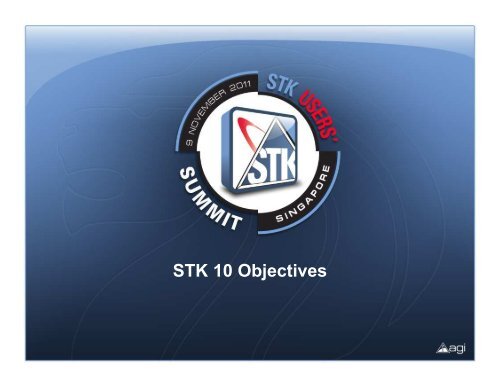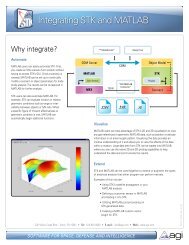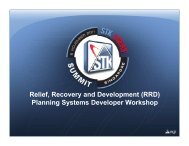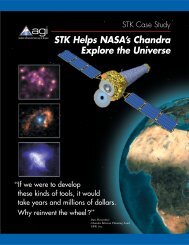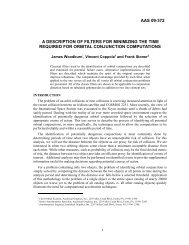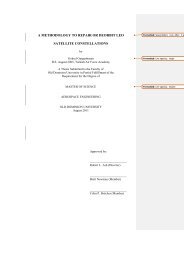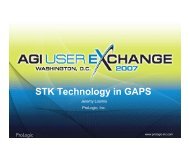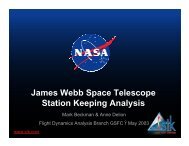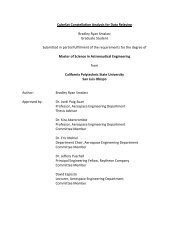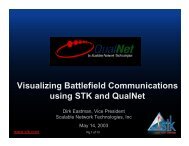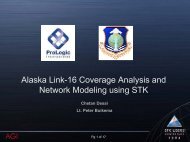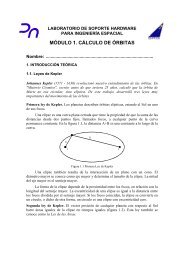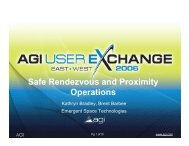STK 10 Overview - AGI
STK 10 Overview - AGI
STK 10 Overview - AGI
- No tags were found...
You also want an ePaper? Increase the reach of your titles
YUMPU automatically turns print PDFs into web optimized ePapers that Google loves.
Systems Tool Kit version <strong>10</strong>Engineers/developers Analysts/Operators Consumers<strong>STK</strong> DesktopData productsData productsWorkflows<strong>STK</strong> SDKsToolsData products
Systems Tool Kit version <strong>10</strong>Engineers/developers Analysts/Operators Consumers<strong>STK</strong> DesktopData productsData productsWorkflows<strong>STK</strong> SDKsToolsData productsAnalysisservices<strong>STK</strong> ServerWebServicesWeb/mobileapplications
Systems Tool Kit version <strong>10</strong>Web BrowserOne-click PublishingMulti-core serverwith <strong>STK</strong> ServerinstalledCustom SOAClient App Easily incorporate <strong>STK</strong> models and analysiswithin any web-service compliant tool.Third-party Clients
Systems Tool Kit version <strong>10</strong> Software framework for mission modeling and analysis– Desktop– Server– Web– Software Development Kits Engineering, planning, situational awareness, ops analysis Organizational use– Ease of use– Data availability and integration– Server and web integration
What’s Coming in <strong>STK</strong> <strong>10</strong>2D Map Improvements
Background <strong>STK</strong> 3 through <strong>STK</strong> 9– 2D map graphics drawn using a layered approach Device independent layer Device rendering layer– Rendering layer based on Microsoft GDI (GraphicsDevice Interface)– Graphics card accelerated on Windows XP dependingon card and driver and to a certain degree on Windows7, but not on Vista– Limited on effects such as translucency, blending,texturing
Background <strong>STK</strong> <strong>10</strong>– Rendering layer replaced with OpenGL-basedInsight3D rendering– Fully accelerated using modern rendering techniques– All OpenGL capabilities available for user’s video cardand driver
Imagery Updates Bing maps now free in <strong>STK</strong> Basic 2D map supported formats now include:– Bing maps with LOD switching for zoom/pan– GIS data via Esri mxd files as image inlays– jp2 and pdttx as background images Effects– Mipmapping used to smooth imagery– True translucency for overlapping images
General Features Pan Mouse wheel zoom in/out True translucency for imagery, sensor andarea target fill, coverage On/Off toggle buttons in object browser Color Selector in object browser Sun Lighting effects
Coverage Changes <strong>Overview</strong>Use of Insight3D renderer in 2D enables largeperformance gains in both 2D and 3DCoverage graphics layer modified toimprove:– Smooth contour rendering performance in 2D and 3D– Displaying of block contours over terrain in 3D– Displaying of smooth contours at altitude in 3DCoverage graphics GUI changed for usabilitywith new 2D/3D options
Coverage Smooth ContoursNatural neighbor interpolation now computedusing graphical method with VoronoidiagramsData computed only when grid definitionchanges and storedDynamic texture updated each animationstep from Voronoi diagram data and FOMgrid point values
Coverage Display at Altitude in 3DTriangle meshes used to display results ataltitudeSurface meshes used to display results overterrainMeshes will be textured when smoothcontours are used and simply colored forblock contours
What’s Coming in <strong>STK</strong> <strong>10</strong> – NewComputational Analysis Tools
ADF/ SOC ADF– Easier interface– Searching (more metadata)– Multi-select– Added API for <strong>STK</strong>/Engine interoperability SOC– Adding UAV payload data– More Satellite data– <strong>10</strong>00 facilities w/ ground az/el masks (SRTM or other)– Moving into creating a Publicly editable catalog
ADF/ SOC
<strong>STK</strong>/Aircraft Mission Modeler (AMM) New features– Full support for wind + strategies– Refueling and dumping during mission– Plugin attitude: higher fidelity modelling– Retasking framework– Basic maneuver procedures Loops, rolls, full 3D intercepts– Updated terrain following Multiple airspeeds and goals– New Aircraft flight performance catalog New GUI, Views, Queries, improved DAFIF, ARINC 424
<strong>STK</strong>/Aircraft Mission Modeler (AMM) New Catalog GUI showing ARINC and DAFIFdata sources + performance models:
<strong>STK</strong>/Aircraft Mission Modeler (AMM) Wind models:– Constant– NOAA ADDS Wind
<strong>STK</strong>/Aircraft Mission Modeler (AMM) Basic Maneuver procedure
<strong>STK</strong>/Aircraft Mission Modeler (AMM) Basic Maneuver procedures
<strong>STK</strong>/Communications New features– enhanced Plugin scripting interface– Adaptive filtering, modulation, gain control - feedbackcontrol loops Will allow you to:– Model Power and Frequency control – Military Radios– Adaptive bit rate as function of feedback control loops– Add processing delays to your signal processing chain
New and Improved Tools in <strong>STK</strong> <strong>10</strong> Motivation– Better leverage <strong>STK</strong> computational engine standardize common computational types increase connectivity between computations provide ability to derive new computations at runtime– Improve debugging and provide in-depth validation– Streamline retrieval of results– Facilitate task-oriented workflow
Geometric Components Vector Geometry Tool (VGT)– Encapsulates time-dynamic geometric computations –core of <strong>STK</strong> computational engine– Computational types Axes, Vectors, Points, Systems, Planes, Angles– Many VGT components are installed out-of-the-box 94 for default Satellite– Users can add components using operations onexisting components existing components - from other objects and other tools (Timeand Calculation), both installed and user-created components 66 operations
Time Components Time Tool– Encapsulates time related computations – core of <strong>STK</strong>computational engine– Computational types Time Instant, Interval, Interval List, Collection of Interval Lists,Time Array– Many Time components are installed out-of-the-box 13 for default Satellite– Users can add components using operations onexisting components existing components - from other objects and other tools (VGTand Calculation), both installed and user-created components 30 operations – time shift, logical, times of extremum,satisfaction times, etc.
Time Components Timeline View– Dedicated window for display of Time components Multi-line display Scrollable and zoom-able Animation marker and custom annotation markers Multiple stored views
Calculation Components Calculation Tool– Encapsulates most other computations and providesalgebraic, functional and calculus operations– Computational types Scalar, Condition, Collection – Attitude, Trajectory, Orbit,Vector, Ground Trajectory, Data Providers– Many Time components are installed out-of-the-box– Users can add components using operations onexisting components existing components - from other objects and other tools (VGTand Time), both installed and user-created components 20 operations – algebraic operations, elementary andpolynomial functions, integral and derivative, etc.
Streamlining Reporting and Graphing <strong>STK</strong> Data Providers and Report Manager– Reports and Graphs are based on styles Styles describe which data provider elements should beincluded Many styles are installed New styles can be created within Report Manager VGT, Time and Calculation components (installed and usercreated)are automatically available as data providers Reporting and Graphing directly from Timeand Calculation tools– Report and graph styles are generated on-the-fly– Can be saved to Report Manager if needed
Object-Centered Approach Advantages– Typically few objects with straightforward relationships Parent-child, Access from-to, Assets or grid points in Coverage– Natural for visualization– Default object configurations work well for typical users Limitations– Most objects are complex with many configurationparameters– Need in-depth knowledge of object design to identifyrelevant parameters and data provider elements– Difficult to add new computations or create newcomputational pathways
Alternative to Object-Centered Approach Advantages– Computational components are simple and have clearrelationships Vector cross product, Elevation angle, Times when elevationangle above threshold, etc.– Easy to add new computations and create newcomputational pathways– Easy to debug and obtain results from individualcomponents Limitations– Many components with many connections may beneeded
Summary <strong>STK</strong> new approach– Retain object-centered approach for typical problems– Expand computational capabilities to solve newproblems using new computational components andtools Have each object provide various computational components Use new computational tools to manipulate and create newcomponents as well as report/graph and visualize their data
Examples
What's Coming in <strong>STK</strong>Parallel Coverage ComputationsAccelerated Analysis for Increased Productivity and Insights
Let’s face itwaiting stinks! It’s boring
Let’s face itwaiting stinks! It’s frustrating
Let’s face itwaiting stinks! And sometimesstressful!
Let’s face itwaiting stinks! It reduces productivity And increases budget
<strong>AGI</strong> is here to help <strong>STK</strong> is getting faster– Parallel processing– Leverages multi-core processors Already in <strong>STK</strong> 9.2.2– Terrain processing– Imagery rendering– Vehicle propagation Parallel coverage on the way
<strong>STK</strong>/Coverage Analyzes when andhow well regions on orabove the Earth are covered bymission assetsExample: Aircraft Sensor Coverage over Terrain
Coverage: a perfect fit for parallelprocessing Comprised of manyindependent calculations Can be grouped and runconcurrently Results gathered andcombined All transparent to user,except for speedProblemCPUCPUCPUCPU
Example parallel coverage applicationAerial search and rescue– Hiker lost in Yosemite National Park– Evaluate airborne search strategyCoverage definition– 790 sq-km area– 250 meter grid resolution (14,580 pts)– 30 meter terrain– Sensor field-of-view– 1 hour analysis periodDell Precision M4400 laptop– Intel Core2 Extreme (4 Cores)– 2.53 GHz CPU, 3.48 GB of RAMSource: ACR Electronics (www.acrelectronics.com)
Example results 3.6X acceleration fromparallel processing– 1-core: 14:49– 4-cores: 4:42 Additional gains possible– 8-cores: 2:32– 16-cores: 1:35
New extensions for <strong>STK</strong>/Coverage Parallel Computing Extension– Use up to 8 local cores Cluster Computing Extension– Use 16 or more cores located anywhere on network Local machine, other workstations and servers– Available in core counts of 16, 32, 64, 128 and 256 Benefits– Accelerated analysis– Larger problems– Increased fidelity and insights


